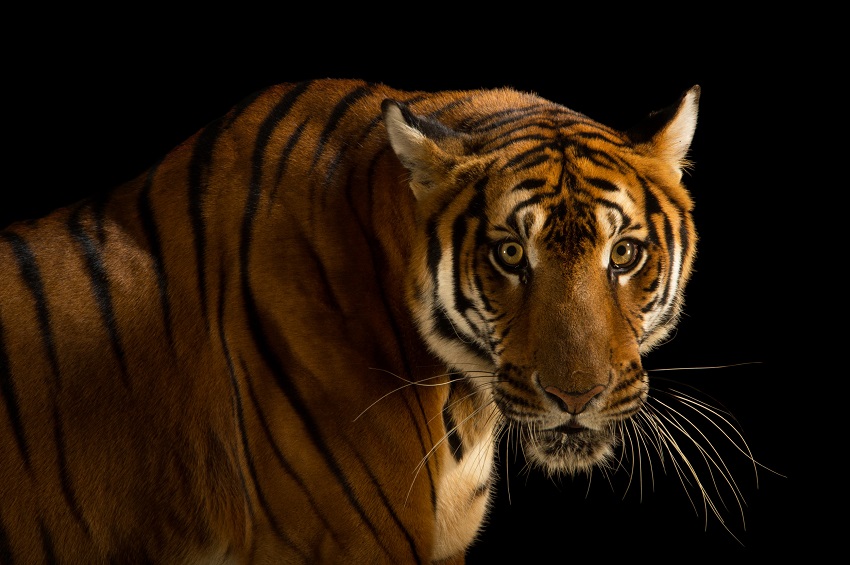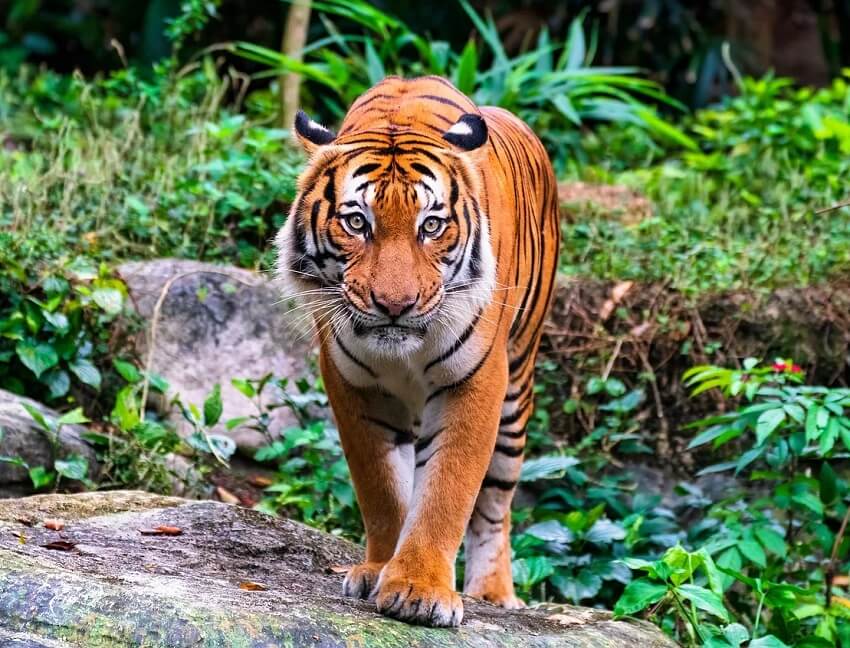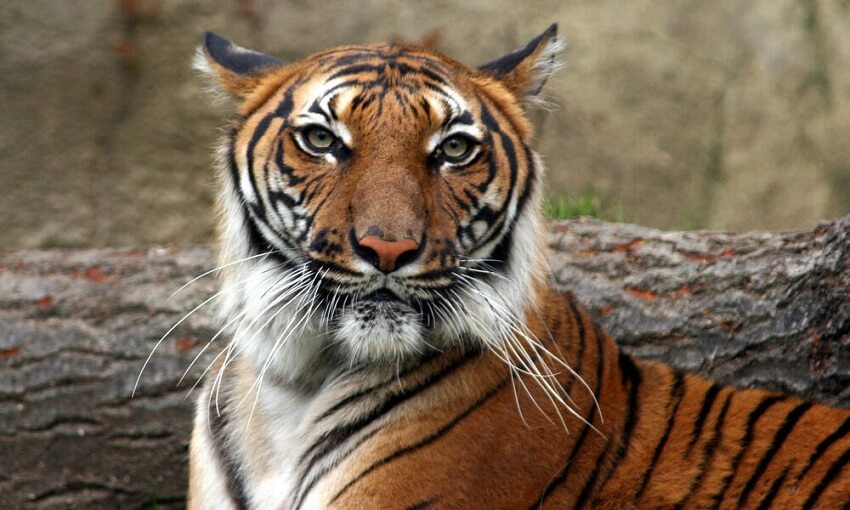Tigers, the “lords of the jungle,” are iconic symbols of strength. Unfortunately, wild tiger populations have been in continuous decline over the past few decades. Currently, there are fewer than 4,000 tigers left in the wild. Join KnowAllAnimals to explore the list of the 6 of the Rarest Tigers in the World in the following article!
1. Top 6 of the Rarest Tigers in the World You Need to Know
Tigers have been a main attraction at zoos worldwide and have fascinated humans for centuries. Yet, despite this admiration, they are one of the most critically endangered species on Earth.
6 of the Rarest Tigers breeds below are all either endangered or critically endangered.
One of the tigers on this red list is now even considered to be extinct in the wild, with only a few individuals remaining in captivity.
While many factors contribute to the decline of the world’s wild tiger populations, the biggest threats they face come from human activities, including illegal hunting, shrinking habitats, and being killed by humans.
It is hoped that raising awareness about the current plight of these majestic predators can contribute to their conservation.
1.1. South China Tiger
- Current Estimated Population: Functionally extinct in the wild, with about 100 or more in captivity.
- Habitat: Southeastern China – primarily in the Hainan Humid Forests.
- Current Conservation Status: Critically Endangered.
- Scientific Name: Panthera tigris amoyensis.
The South China Tiger has been declared “functionally extinct” in the wild by scientists, making it the rarest tiger species in the world. While the South China Tiger hasn’t been seen in its natural habitat for over 25 years, there are approximately 100 tigers in captivity, and breeding programs are still underway.
It was previously thought that the captive population of the South China Tiger was too small and lacked genetic diversity, but since the establishment of a studbook a few years ago, there is some hope that the South China Tiger could be reintroduced into the wild in the future.
In the early 1950s, it was estimated that there were about 4,000 wild South China Tigers, but those numbers dropped significantly in a few decades. Thousands of South China Tigers were killed as “pests,” and many more died due to habitat degradation.
The skull of the South China Tiger differs from all other surviving tiger species. Therefore, the South China Tiger is considered the primitive tiger species from which all other current tigers evolved.

1.2. Malayan Tiger
- Current Estimated Population: 250–340.
- Habitat: Southern and central parts of the Malay Peninsula; the southern tip of Thailand.
- Current Conservation Status: Critically Endangered.
- Scientific Name: Panthera tigris jacksoni.
Before 2004, the Malayan Tiger was classified as the same species as the Indochinese Tiger. However, after genetic analysis, it was determined that the Malayan Tiger was its own subspecies and was named Panthera tigris jacksoni in honor of Peter Jackson, a renowned tiger conservationist (not the famous film director).
As its name suggests, the Malayan Tiger is primarily found in the southern and central parts of the Malay Peninsula. There is also a small population of Malayan Tigers at the southern tip of Thailand. The biggest threat to the Malayan Tiger population is rampant deforestation for logging and road construction, which is shrinking their habitat.
In the Malay language, the Malayan Tiger is called harimau, often shortened to rimau.

1.3. Indochinese Tiger
- Current Estimated Population: approximately 350 individuals
- Habitat: Myanmar; Thailand; Laos; Vietnam; Cambodia; Southwestern China (possibly extinct in this region).
- Current Conservation Status: Endangered.
- Scientific Name: Panthera tigris corbetti.
The Indochinese Tiger is native to Myanmar, Thailand, Laos, Vietnam, Cambodia, and Southwestern China. However, scientists believe the Indochinese tiger may be extinct in China as no individuals have been sighted in that region in recent years.
Research also suggests that there may not be any purebred Indochinese Tigers left in Cambodia and Vietnam.
Although all tigers are quite mysterious, the Indochinese tiger is solitary and elusive, so little is known about the behavior of this animal in the wild. Of all the remaining tiger subspecies, the Indochinese Tiger is the least represented in captive populations. Since the Malayan Tiger was separated into its own subspecies in 2004, the number of Indochinese tigers in zoos worldwide is believed to be lower than before.
The scientific name of the Indochinese Tiger, Panthera tigris corbetti, pays homage to Jim Corbett, a British hunter who took down man-eating tigers and leopards in India but later became a renowned conservationist.

1.4. Sumatran Tiger
- Current Estimated Population: 400–600.
- Habitat: Sumatra, Indonesia (Sunda Islands).
- Current Conservation Status: Critically Endangered.
- Scientific Name: Panthera tigris sumatrae or Panthera tigris sondaica.
The Sumatran Tiger is the last remaining tiger species in Indonesia’s Sunda Islands, which were once home to the Bali and Javan Tigers. The Bali Tiger became extinct in the 1950s, while the Javan Tiger was last sighted in the 1980s.
Information sources vary, but it’s estimated that there are between 400 to 600 Sumatran tigers left in the wild.
DNA analysis shows that the Sumatran Tiger became isolated from other tiger populations after sea levels rose 12,000 to 6,000 years ago. As a result, the Sumatran Tiger evolved differently and has no problem living on its home island.
The Sumatran Tiger population is declining primarily due to human activities, such as the expansion of palm oil plantations.
The Sumatran Tiger is the smallest tiger subspecies, and also has the darkest coat color (dark orange) and the highest stripe density compared to other tigers.

1.5. Siberian Tiger
- Current Estimated Population: 500–600.
- Habitat: Russian Far East; Northeastern China; and possibly North Korea.
- Current Conservation Status: Endangered.
- Scientific Name: Panthera tigris altaica.
The Siberian Tiger, also known as the Amur tiger, is primarily found in the dense forests of Russia’s Far East, but it also lives in parts of Northeastern China and possibly North Korea. In the past, the Siberian Tiger’s range was much larger and could be found throughout the Korean Peninsula, northern China, and Mongolia, in addition to the Russian Far East.
Unfortunately, overhunting has almost decimated the wild Siberian Tiger population, and its numbers have fluctuated over the years. After Russia became the first country to grant full protection to the Siberian Tiger subspecies, the population stabilized at more than 500 but is still below 600.
In captivity, the Siberian Tiger is the largest of the remaining tiger subspecies, weighing up to 300 kg (661 lbs) and measuring 3.28 meters (10.7 feet) long. However, wild Siberian tigers can be even larger.

1.6. Bengal Tiger
- Current Estimated Population: 2,603–3,346 individuals.
- Habitat: Indian subcontinent (Bangladesh, Nepal, and Bhutan).
- Current Conservation Status: Endangered.
- Scientific Name: Panthera tigris tigris.
As the tiger subspecies with the highest population, the Bengal Tiger can be found in zoos and wildlife parks around the world, and even in live performances in Las Vegas.
Although their numbers are higher than the other five rarest tigers combined, the Bengal Tiger is still classified as an endangered animal. Like all other tigers, the Bengal Tiger population is declining and primarily faces threats from human activities, especially illegal hunting.
The reason for the Bengal Tiger’s high population (compared to other tiger subspecies) is that many individuals have been in captivity since 1880 and have been widely crossbred with other tiger subspecies.

2. FAQs
1. Which tiger on the list is considered “extinct in the wild”?
The South China Tiger is currently considered extinct in the wild, with remaining individuals only living in conservation and captive breeding programs.
2. What are the six rarest tiger species?
The list includes: the South China Tiger, Malayan Tiger, Indochinese Tiger, Sumatran Tiger, Siberian Tiger (Amur), and Bengal Tiger.
3. What is the main reason for the sharp decline in tiger numbers?
The main threats come from illegal hunting, habitat loss, and human-tiger conflict – factors that are causing wild tiger populations to continuously decline.
4. Where do South China Tigers still live, apart from captive breeding programs?
According to available information, this species no longer exists in the wild and is only found in captive facilities and conservation programs.
5. How many wild tigers are left globally?
There are currently fewer than 4,000 wild tigers left in nature, which clearly shows the critical situation facing this iconic species.
Tigers are not only symbols of strength and power in nature but also a clear testament to the challenges that biodiversity is facing. The Top 6 of the Rarest Tigers in the World are dwindling due to poaching and habitat loss, placing them in a critical situation. Conservation efforts not only help ensure the survival of tigers but also contribute to preserving the ecological balance of our forest ecosystems. Every small action – from raising awareness and supporting conservation programs to fighting illegal poaching – is a crucial step toward ensuring tigers continue to exist on Earth.



